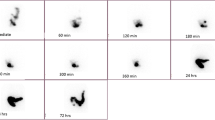Abstract
We aimed to develop a simple, clinically useful technique for measuring gut transit time in patients with an ileostomy, in order to distinguish easily when patients have fast or slow transit. Seventeen healthy subjects (mean age, 55 years; range, 43–71 years; nine males) who had had a proctocolectomy for ulcerative colitis more than 1 year previously and without small intestinal resection were studied. Subjects were studied on 4 days after an overnight fast, two studies with and two without breakfast. A standard diet was used on all days. Twenty radiopaque markers were given at the start of each study day. Ileostomy effluent was collected over 24 hr and x-rayed to determine the number of retained markers. Studies with breakfast demonstrated greater intrasubject reproducibility. The mean transit time for passage of 50% of markers was 16.6 hr with, and 14.8 hr without, breakfast (p < 0.02). From the data obtained we suggest that the optimum time for taking a single abdominal radiograph in a patient with suspected fast transit is 6 hr after ingestion of markers, while the optimum time for a patient with suspected slow transit is 24 hr.
Similar content being viewed by others
References
Cummings JH, Jenkins DJA, Wiggins HS: Measurement of the mean transit of dietry residue through the human gut. Gut 17:210–218, 1976
Bland JM, Altman DG: Statistical methods for assessing agreement between two methods of clinical measurement. Lancet 307–310, 1986
Staniforth DH, Rose D: Statistical analysis of the lactose/breath hydrogen test in the measurement of orocaecal transit: Its variability and predictive value in assessing drug action. Gut 30:171–175, 1989
La Brooy SJ, Male P-J, Beavis AK, Misiewicz JJ: Assessment of the reproducibility of the lactulose H2 breath test as a measure of mouth to caecum transit time test. Gut 24:893–896, 1983
Meyer J, Thornson J, Choen MB, Schadchehr A, Mandiola SA: Sieving of solid food by canine stomach and sieving after gastric surgery. Gastroenterology 76:804–813, 1979
Meyer J, Ohaslis H, Joh D, Thornson J: Size of liver particles emptied from the human stomach. Gastroenterology 80:1489–1496, 1981
Richter HM: Normal gastrointestinal motility: Stomach and duodenum.In An Illustrated Guide to Gastrointestinal Motility. D Kumar, S Gustavsson (eds). Chichester: John Wiley and Sons, 1988, pp 163–174
Author information
Authors and Affiliations
Rights and permissions
About this article
Cite this article
Goldberg, P.A., Kamm, M.A. & Nicholls, R.J. A radiopaque marker technique for measuring gastrointestinal transit in subjects with an ileostomy. Digest Dis Sci 41, 2302–2306 (1996). https://doi.org/10.1007/BF02100118
Received:
Revised:
Accepted:
Issue Date:
DOI: https://doi.org/10.1007/BF02100118




